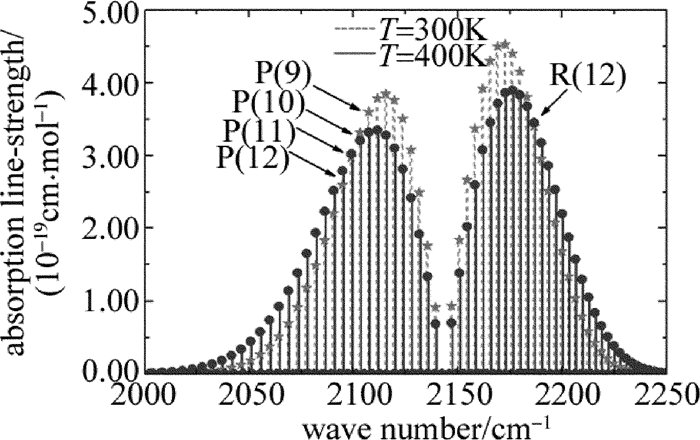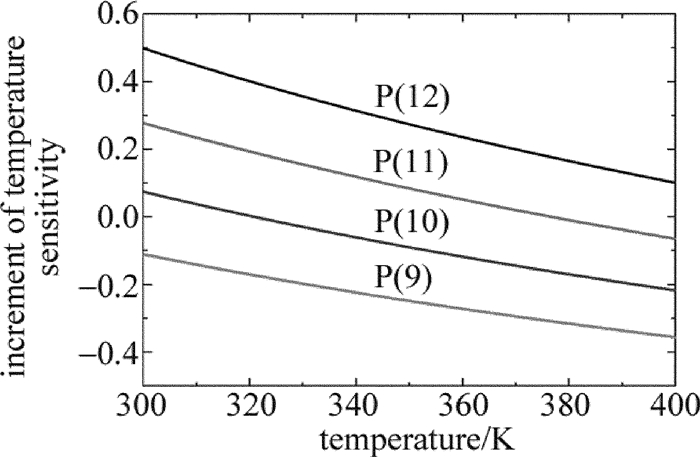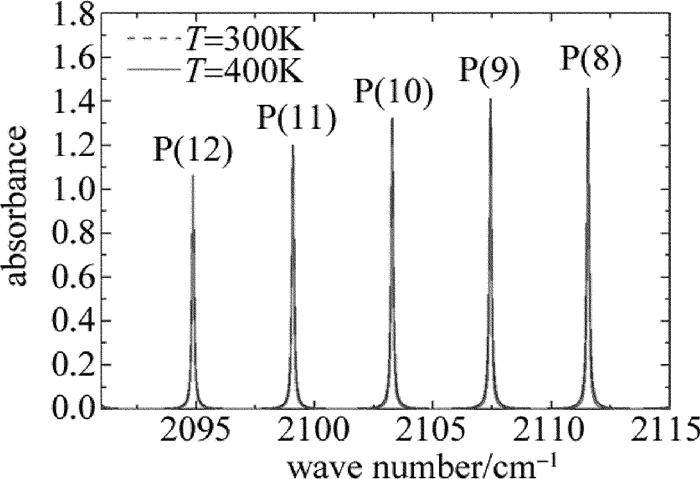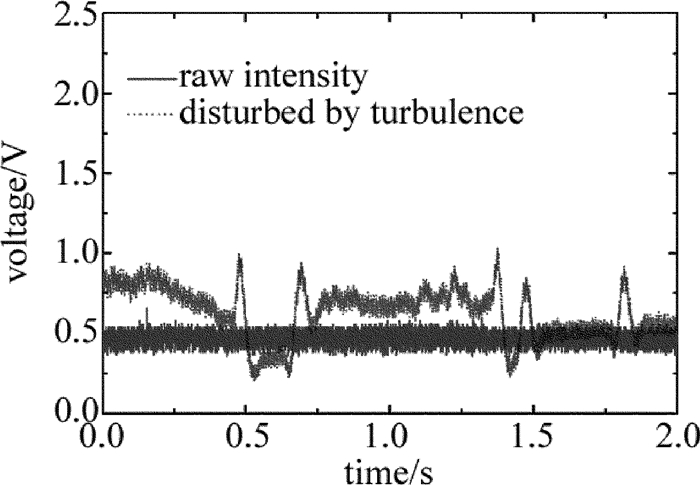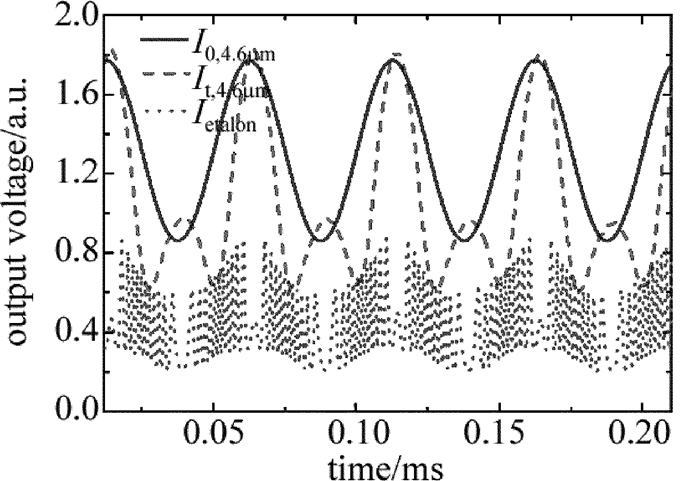HTML
-
伴随我国机动车保有量的持续增加,尾气排放所造成的城市大气环境污染已然成为当前严峻的问题[1]。机动车尾气由污染气体一氧化碳、氮氧化合物(nitrogen oxide, NOx)、非甲烷类碳氢化合物(hydrocarbons, HCS),以及温室气体二氧化碳组成。其中CO是由于发动机碳氢燃料非充分燃烧所产生,过量排放会对人体健康造成极大的危害[2],并且会间接加剧全球温室效应[3]。
基于光谱技术对发动机CO排放检测已经有很多光学遥感检测手段,美国通用汽车研究实验室的STEPHENS等人基于非红外分散技术(non-dispersive infrared, NDIR)的方法实现了CO排放量测量[4]。美国马里蒙特大学MEDHURST等人基于红外傅里叶变换光谱(infrared Fourier transform spectroscopy, FTIR)的方法实现了对发动机尾气污染物HCS, NO, CO等测量[5]。近年来,我国对于发动机CO排放检测也取得了巨大进展,中国科学院合肥物质科学研究院CHEN等人基于NDIR的方法设计了用于尾气检测的传感器,通过优化定标算法实现低浓度的CO及CO2检测[6],并且通过仿真计算NDIR传感器响应函数等进一步提高了设计精度[7]。除此之外,其它光谱诊断技术还有激光诱导击穿光谱(laser induced breakdown spectroscopy, LBIS)[8]、平面激光诱导荧光(planar laser induced fluorescence, PLIF)[9]、腔衰荡光谱(cavity ring-down spectrum, CRDS)以及腔增强吸收光谱(cavity enhanced absorption spectroscopy, CEAS)[10-11]等。
在众多的研究工作中,激光吸收光谱技术(laser absorption spectroscopy, LAS)因其具有组分选择、响应快、可实现性强等特点迅速发展成为气体浓度测量的重要手段之一。西北核工业技术研究所LIU等人对基于激光诊断技术在组分测量应用方面做了详细的介绍与分析[12]。其中,可调谐半导体激光吸收光谱技术(tunable diode laser absorption spectroscopy, TDLAS)作为气体组分浓度测量的基础技术已经发展得较为成熟[13-15]。清华大学CHAO等人基于TDLAS技术实现了对火力发电厂700K燃烧环境下的CO浓度长时监测[16]。中国科学院力学研究所ZAHNG等人基于TDLAS实现了不同喷注压力下的对二硝酰胺铵(ammonium dinitramide, AND)基发动机燃烧室内CO摩尔分数进行测量[17]。随着室温下可调谐量子级联激光器(quantum cascade laser, QCL)的商业化发展,为激光光谱测量提供了高功率、窄线宽、单模、无跳模特性的理想光源,使激光诊断技术的工作波段拓展至中远红外波段成为可能。常见的燃烧产物H2O, CO, CO2的谱线在中红外波段内多为基频跃迁,谱线强度较强,更易于吸收光谱信号探测,因此具有高分辨、高灵敏等特点的量子级联吸收光谱技术(quantum cascade absorption spectroscopy, QCLAS)逐渐被应用于具体的诊断测量工作中[18-20]。
然而,基于吸收光谱技术在发动机尾气中CO含量检测的实际应用中,CO在近红外波段内谱线较弱,且浓度较低,不易检测,鉴于此,作者将测量谱线的选取拓展至中红外波段, 选取谱线较强的基频跃迁谱线带。发动机尾气逸散过程中具有温度变化范围广,光谱信号强度大小易受温度波动影响,导致光谱测量结果不精确,因此,本文中通过仿真模拟结果,创新性地选取CO基频跃迁带中对温度不敏感谱线P(10),降低温度对谱线强度大小的影响。另外,在实际数据采集过程中,由于尾气湍流波动较大等特点使得光谱信号获取极不稳定,在光谱数据采集设计中,本工作利用量子级联激光器的超快频率扫描特性加以20kHz的高频扫描,采取单条谱线测量浓度方法,实现了湍流波动较大环境下的吸收光谱数据高速采集,最终获取尾气中CO体积分数随时间的变化的信息,为实际道路尾气CO体积分数测量提供了一个良好的激光遥感监测方案。
-
单色激光与待测气体的相互作用过程可以用受激吸收模型来表示,量子级联激光器发出的单色激光光强为I0, 经待测气体传输后的光强衰减至It,二者满足Beer-Lambert定律, 可表述为:
式中,I0, It分别为量子级联激光器的激光光束入射光强和出射光强,σ为吸收截面,L为待测气体沿激光水平方向上的平均吸收路径, xCO为CO气体的体积分数。
待测体积分数xCO通过(1)式可以进一步表示为:
式中,λ为激光器的中心波长。
-
最优谱线的选取是量子级联激光吸收光谱浓度测量传感器模型设计尤为关键的一步,直接决定着传感器性能的优良,因此合适的目标工作波段选择会为传感器的设计建立较好的基础。发动机碳氢燃料不完全燃烧产生的CO气体在近红外第一泛频带2.3μm(分子谱带跃迁能级Δν=2)、第二泛频带1.55μm(Δν=3)以及中红外基频带4.6μm(Δν=0)处均有吸收,其中4.6μm处的CO分子属于基频跃迁,谱线强度最强。如图 1所示,根据HITRAN 2016数据库[21]计算了中红外波段2000cm-1~2250cm-1范围内,发动机常见的燃烧产物H2O, CO2, CO等标准大气压下吸收谱线强度分布,可以明显看出,在此波段内CO谱线吸收较强,并且周围H2O与CO2的干扰较小,有利于提高传感器的信噪比,增加测量结果的精度。
分子谱线强度S(T)是温度T的函数,可以表示为:
式中, S(T0)是温度296K的谱线强度,S(T)为温度T的谱线强度,Q(T0)为296K的配分函数,Q(T)为温度T的配分函数, ν为分子跃迁中心频率, E″为低能级能量。由(3)式可知,谱线强度S(T)受温度T变化而变化,其谱线温度敏感性可表示为:
式中,ΔE″为低能级能量的差值,h, c, kB分别为普朗克常数、光速、玻尔兹曼常数, R为谱线强度的比值。
如图 2所示,根据机动车尾气中CO气体逸散过程中温度变化范围大致为300K~400K的实际情况,计算了CO在300K, 350K, 400K下的谱线强度,可以看出各支谱线强度对温度敏感程度也大不相同。其中,R支中R(12)与P支中P(10)谱线温度敏感性较低,由于本工作所使用的量子级联激光器工作波段为2010.00cm-1~2200.00cm-1,因此初步选择P支中温度敏感性较低的P(9), P(10), P(11), P(12)谱线作为候选谱线,可以最大程度上降低CO气体体积分数反演结果受温度变化的影响。
根据图 2中的计算结果,对低温度敏感性谱线P(12), P(11), P(10), P(9)谱线做进一步温度敏感性计算,候选谱线详细参量在表 1中已经列出。计算结果如图 3所示,并在表 2中列出其差值数值结果,其中,4条谱线温度敏感性改变量最低的为P(10)谱线。

Figure 3. Temperature sensitivity of candidate lines for P(12), P(11), P(10), P(9) at temperature range of 300K~400K
line center frequency/ cm-1 absorption line-strength/ (cm·mol-1) energy of low state/ cm-1 P(9) 2107.42 3.607×10-19 172.98 P(10) 2103.26 3.319×10-19 211.40 P(11) 2099.08 2.967×10-19 253.67 P(12) 2094.86 2.581×10-19 299.77 Table 1. Parameters of candidate lines
line P(9) P(10) P(11) P(12) the decrease of temperature sensitivity 0.466 0.29182 0.34267 0.39802 Table 2. Temperature sensitivity difference of candidate spectra in the range of 300K~400K
针对实际应用环境,对候选谱线P(10)及其邻近谱线吸光度以及归一化谱线强度做了进一步计算,模拟结果如图 4、图 5所示。结果表明,在300K和400K温度下,中心波数为2103.26cm-1的低温度敏感性候选谱线P(10)谱线强度相差为9.2%,受温度波动影响较小,可以作为发动机CO排放监测实际应用候选谱线。
1.1. 单波长浓度测量原理
1.2. 谱线选取
-
实验装置如图 6所示。其中量子级联激光器(dayLight solution)的中心波长为4.6μm,可以在2010.00cm-1~2200.00cm-1范围内连续调谐无跳模函数发生器(Tektronix AFG 3022B)提供频率为200Hz~2MHz的标准正弦信号,用于调谐激光器的输出波长,从而实现吸收谱线连续、快速扫描。QCL输出的激光由光路上的CaF2分束镜1(Thorlabs BSW520)分为两路,其中透射光经过自由光程(free spectrum range, FSR)为0.012cm-1的F-P(Fabry-Perot)标准具(LightMachinery OP-5483-101.6),中心波长为4.6μm的红外带通滤光片, 再经由红外光电探测器接收。反射光经过中心波长为4.6μm的红外带通滤光片作为参考光路被红外光电探测器接收,探测器内置的前端放大器(VIGO MIPDC-F-20)具有20MHz的带宽,满足高速信号采集需求;再经过CaF2分束镜2(Thorlabs BSW520)分为两路,其中透射光经过目标待测气体和中心波长为4.6μm的红外带通滤光片被红外光电探测器接收。反射光经过中心波长为4.6μm的红外带通滤光片被相同型号的探测器接收。3组探测器的输出信号由10GHz/s最高采样率,500MHz带宽的数字示波器(Tektronix MSO5)采集。实验中采用20kHz的高频扫描方案,尽量减小尾气湍流对吸收光谱测量的影响并且有效提高测量时间分辨率,真实还原尾气逸散过程中的浓度变化。
-
通过对比尾气湍流对激光强度抖动的影响,如图 7所示。图中,实线为未经过尾气湍流区域的参考光路,点虚线为经过湍流区域的信号光路,明显可以看到尾气湍流对激光光强有较大的影响。启动发动机,使用中心波长为4.6μm量子级联激光器对所选CO吸收谱线P(10)进行20kHz的高速扫描,并利用探测器接收激光输出信号,待发动机工况稳定后开始测量,示波器采集到的各路电压信号经过倍数变换处理后如图 8所示。图中横虚线为吸收光谱输出电压信号,实线为参考光路电压信号,点虚线为标准具电压信号,用以标定波长。
通过计算采集到的吸光度,并带入(1)式、(2)式,可以得到发动机沿测量光路上CO体积分数信息及其随时间演化。根据激光器工作范围内可扫描的谱线及模拟温度范围内的结果,选择不同温度下谱线强度差异最大和最小的谱线计算可知,P支谱线扫描范围内可降低48.28%目标气体温度变化对体积分数反演的影响,如图 9所示,CO体积分数波动与发动机工作冲程基本保持一致,其体积分数为(153±123)×10-6。
-
基于量子级联吸收光谱(QCLAS)提出了一种较为实用的发动机CO体积分数遥感监测方案,选择温度敏感性较低的谱线P(10), P支谱线扫描范围内可降低48.28%目标气体温度变化对体积分数反演的影响,并利用20kHz频率的超快扫描克服发动机尾气湍流对测量光谱的干扰,从而实现CO体积分数的精确测量,时间分辨率高达20kHz。该方法可以为燃烧环境较为恶劣且目标气体温度变化范围大的应用环境提供良好的测量方案,具有极大的应用潜力。在未来的工作中,将继续完善传感器工业化设计,并进一步深入研究CO体积分数标定的方法。

 Map
Map


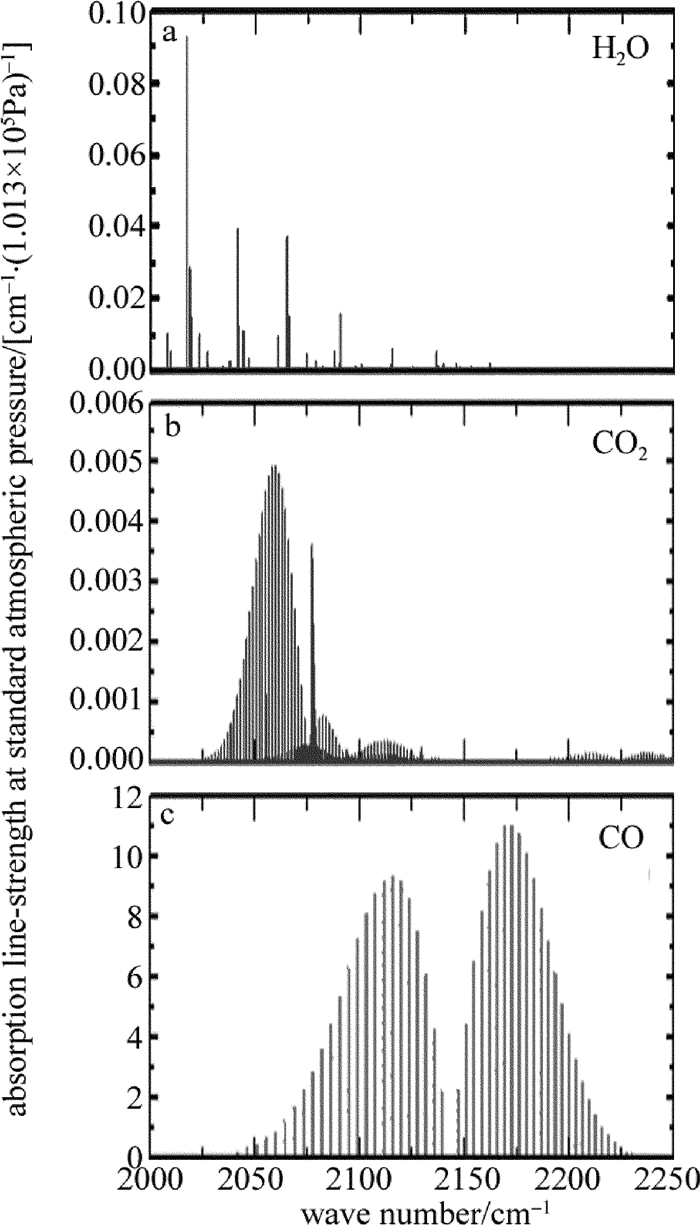

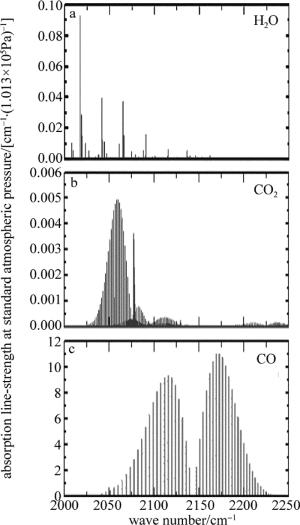

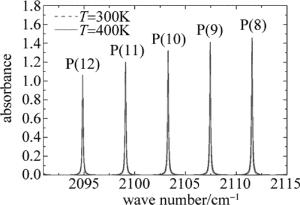
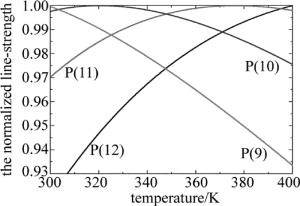
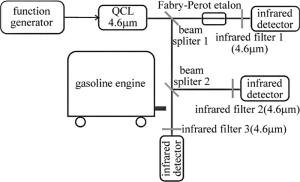

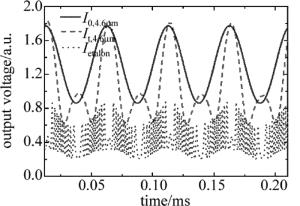

 DownLoad:
DownLoad:
